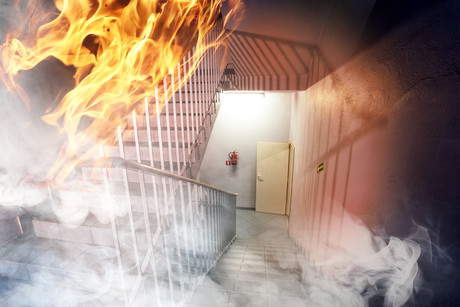Six ways to keep buildings and workers safe from fire

Fire poses a serious risk to the safety and welfare of building occupants, as well as having the potential to have a devastating effect on businesses.
Property loss and damage can result in lengthy downtime while repairs and rebuilding take place, and expensive equipment and important data can be destroyed.
The following advice has been prepared by Wormald to help facility managers protect against fire:
1. Conduct a fire safety audit to highlight potential fire risks around the premises. This will help to determine the fire protection solution required. Hazards will vary depending on the nature of the business or property but can include electrical equipment, kitchen or heating appliances, flammable liquids and combustible waste material. Consulting a fire protection specialist can help to ensure all hazards are identified and the most appropriate fire protection solution is installed.
2. Keep up to date with regulation and legislation. Facility managers must know their responsibilities when it comes to ethical and legal fire safety requirements. Australian legislation and standards relating to fire safety change regularly so it’s important to stay on top of things. Keep up to date on all national and state-based fire safety regulations and standards in relation to fire protection equipment, maintenance or training. It’s a good idea to contact a fire protection specialist. Develop a fire prevention plan in accordance with Australian Standard AS3745-2010 ‘Planning for Emergencies in Facilities’.
3. Install adequate fire protection equipment. Fire protection equipment can include basic fire extinguishers or fire hose reels, passive fire solutions or more advanced fire detection and suppression systems. When deciding on the most suitable fire protection solution, considerations include:
- legislation and standards
- size and type of building
- materials being handled on the premises
- purpose of the building (eg, offices, materials storage, manufacturing).
4. Service and maintain: A high level of reliability is essential when it comes to fire protection. Fire protection systems and equipment should always perform to the standard to which they were originally designed and installed. Regular testing can validate the functionality of the systems and equipment and help uncover any faults or issues that may cause malfunction. Australian Standard AS1851-2005 ‘Maintenance of fire protection systems and equipment’ recommends that fire protection systems be regularly inspected.
5. Provide appropriate signage for all hazards, fire protection equipment and emergency exits. Fire extinguishers and other fire safety equipment should be clearly marked. Emergency exits signs should be visible so that in the event of an evacuation, people can be directed to escape quickly.
6. Train: A confident team that is able to respond appropriately in the event of a fire is an invaluable investment and can substantially reduce the impact of a crisis. Everyone working within a facility should know how to respond to a fire emergency and how to use the fire equipment on-site. Fire safety training can be included in staff induction where new employees are briefed and trained on what to do in the event of a fire. Fire wardens should be fully trained on their responsibilities, fire equipment and the emergency warning and communication systems in their premises.
For some building managers dealing with mandatory fire audits, complying with strict standards and regulatory requirements, and keeping clear and traceable records and reports can seem overwhelming. Fire protection specialists can provide professional advice, helping to take the stress out of maintaining fire protection systems, and provide peace of mind for management.
Contract labour in mining: do savings outweigh safety outcomes?
Australian researchers have analysed decades of research on contract labour in mining, arguing...
Psychosocial risk management: eight trends with tips
Psychosocial risk management has become a central pillar of workplace safety and organisational...
50 in 2024: Victoria's workplace fatalities figures
Transport, construction and agriculture were Victoria's deadliest sectors in 2024, with...










